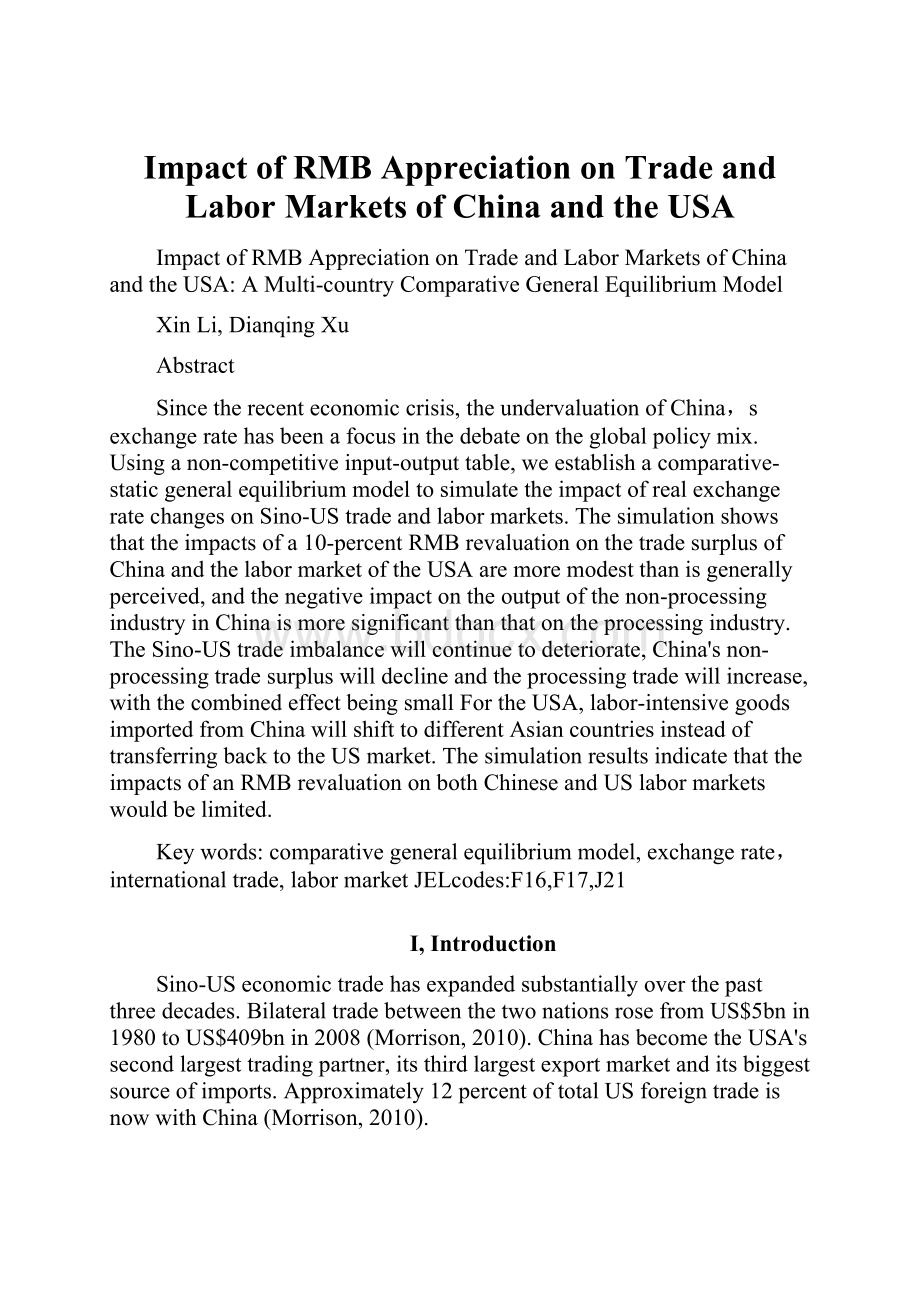Impact of RMB Appreciation on Trade and Labor Markets of China and the USA.docx
《Impact of RMB Appreciation on Trade and Labor Markets of China and the USA.docx》由会员分享,可在线阅读,更多相关《Impact of RMB Appreciation on Trade and Labor Markets of China and the USA.docx(20页珍藏版)》请在冰豆网上搜索。

ImpactofRMBAppreciationonTradeandLaborMarketsofChinaandtheUSA
ImpactofRMBAppreciationonTradeandLaborMarketsofChinaandtheUSA:
AMulti-countryComparativeGeneralEquilibriumModel
XinLi,DianqingXu
Abstract
Sincetherecenteconomiccrisis,theundervaluationofChina,sexchangeratehasbeenafocusinthedebateontheglobalpolicymix.Usinganon-competitiveinput-outputtable,weestablishacomparative-staticgeneralequilibriummodeltosimulatetheimpactofrealexchangeratechangesonSino-UStradeandlabormarkets.Thesimulationshowsthattheimpactsofa10-percentRMBrevaluationonthetradesurplusofChinaandthelabormarketoftheUSAaremoremodestthanisgenerallyperceived,andthenegativeimpactontheoutputofthenon-processingindustryinChinaismoresignificantthanthatontheprocessingindustry.TheSino-UStradeimbalancewillcontinuetodeteriorate,China'snon-processingtradesurpluswilldeclineandtheprocessingtradewillincrease,withthecombinedeffectbeingsmallFortheUSA,labor-intensivegoodsimportedfromChinawillshifttodifferentAsiancountriesinsteadoftransferringbacktotheUSmarket.ThesimulationresultsindicatethattheimpactsofanRMBrevaluationonbothChineseandUSlabormarketswouldbelimited.
Keywords:
comparativegeneralequilibriummodel,exchangerate,internationaltrade,labormarketJELcodes:
F16,F17,J21
I,Introduction
Sino-USeconomictradehasexpandedsubstantiallyoverthepastthreedecades.BilateraltradebetweenthetwonationsrosefromUS$5bnin1980toUS$409bnin2008(Morrison,2010).ChinahasbecometheUSA'ssecondlargesttradingpartner,itsthirdlargestexportmarketanditsbiggestsourceofimports.Approximately12percentoftotalUSforeigntradeisnowwithChina(Morrison,2010).
However,thecurrentglobaleconomiccrisishasstrainedSino-USeconomicrelations.ManyanalystsareconcernedthattheChineseGovernmentmight,inanefforttohelpitssaggingexportindustries,setnewtradebarriers,imposeindustrialsubsidiesordepreciateitscurrency,whichcouldharmUSfirmsandworkers(e.g.Scott,2010).ManyUSpolicymakershaveurgedChinatoreduceitsrelianceonexportsforitseconomicgrowthandtoadoptincentivepoliciestopromotedomesticconsumption.CentraltothispositionisthebeliefthatChinashouldappreciateitscurrencyandadoptafloatingexchangeratesystem,whichcouldboostitsimports.
TherearetwodifferentpointsofviewregardingwhethertheRMBshouldappreciateandthepotentialimpactontheUSeconomy.OneviewisthatanexchangerateappreciationwouldnotsolvetheenlargingUScurrentaccountdeficit.Forexample,Zhangetal.(2006)useacomparativegeneralequilibrium(CGE)modeltoanalyzetheimpactsofanappreciationofChina’srealexchangerateonthetradebalancebetweenChinaandtheUSAandvariousindustriesinbothcountries.TheirresultsindicatethatChina’soutputinbothagricultureandmanufacturingsectorswillincreaseandGhina’sexchangerateappreciationmightnotsolvetheenlargingUScurrentaccountdeficit.Fair(2010)usesamulti-countrymodeltoestimatethemacroeconomiceffectsofanRMBappreciation.TheestimatedeffectsonUSoutputandemploymentaremodest.ThepositiveeffectsonUSoutputfromdecreasedimportsfromChinaareoffsetbythenegativeeffectsonUSoutputfromincreaseddomesticinflationandfromadecreaseinUSexportstoChinabecauseofChina’slikelyeconomiccontraction.EvenettandFrancois(2010)comparethreegeneralapproachestoestimatingtheimpactofanRMBappreciationrelativetotheUSdollarontheUSlabormarket.TheyindicatethatadearerRMBwouldboostthecompetitivenessofUSexportstoChinabutitwouldreduceoverallUScompetitiveness.Aftertakingimportedintermediateinputsintoaccount,anRMBappreciationrelativetotheUSdollarisfoundtoresultinUSjoblosses.
AnotheropposingviewisthatRMBappreciationwillhavepositiveeffectsontheUSeconomy,inparticularontheUSlabormarket.Bergsten(2010)believesthattheRMBisundervaluedbyapproximately25percentonatrade-weightedaveragebasisandbyapproximately40percentagainsttheUSdollar.HepointsoutthatthiscompetitiveundervaluationoftheRMBisablatantformofprotectionismandthatseveralneighboringAsiancountriesmaintaincurrencyundervaluationofroughlythesamemagnitudeinordertoavoidlosingtheircompetitivepositiontoChina(Bergsten,2010).Kmgrnan(2010)suggeststhatoverthenextcoupleofyears,ChinesemercantilismmightendupreducingUSemploymentbyapproximately1.4millionjobs.Gagnon’s(2010)researchsuggeststhata10-percentRMBappreciationwouldboostUSemploymentbyatleast670000jobs.Scott(2010)indicatesthattheUStradedeficitisthemajorreasonforUShighunemployment.HeestimatesthattheUSmanufacturingsectorlost5.3millionjobsfromJanuary2001toSeptember2009.TheUSAhasaccumulatedlargestructuraltradedeficitsoverthepastthreedecades,andin2007,thenon-oilshareinthedeficitswasresponsibleforthelossordisplacementofmorethan5millionjobs.
PreviousresearchmostlyfocusesontheSino-USbilateraltradeandlabormarket’slinkage,whichmightexpandthepositiveornegativeeffectsofRMBappreciationonbotheconomies.Withthedeepeningofglobaleconomicintegration,RMBappreciationcouldalsoimpactSino-UStradeandthelabormarketviaothercountries’indirectlinkages.ThepresentpapercontributestothepublishedliteratureonRMBrevaluationinthreeaspects.First,weestablishanon-competitiveinput—outputtable,whichdistinguishesprocessingtradeandnon-processingtradeintheCGEmodel.Forthelow-costintermediateinputsimport,RMBappreciationmighthavelittleeffectonprocessingmanufacturingexports.Second,ourresearchfocusesonthecontentofvalue-addedinsteadoftotalvalueofexports.TheeffectsofRMBappreciationdependontheextentofdomesticandforeigncontentinthetrade.Ifthedomesticcontentislow(i.e.thevalueofexportsreflectsmostlythevalueofimportedinputs),thentheexchangerateappreciationwouldhaverelativelylittleeffectonexports.Thisisbecausethehigherforeigncurrencypriceoftheexportsispartlyoffsetbythelowerdomesticcurrencypriceoftheimportedinputs.Totheextentthatthedomesticcontentvariesbyindustries,anappreciationoftheRMBisexpectedtohavedifferenteffectsindifferentindustries.Third,weestablishacomprehensivemultinationaldatabase,whichcovers47countriesandregions,and41sectors.
Therestofthepaperisorganizedasfollows.SectionIIoutlinesthebasicsituationofSino-UStrade.SectionIIIdescribesthecomparative-staticgeneralequilibriummodelandthedatausedinthispaper.ThemainresultsandanalysisarediscussedinSectionIV.Finally,SectionVconcludesthepaper.
II.BasicSituationofSino-USTrade
AccordingtothestatisticsoftheUSInternationalTradeCommission,USmerchandiseexportstoChinain2008valuedUS$71.5bn,up9.5percentoverthepreviousyear.In2007,ChinaovertookJapantobecomethethirdlargestUSexportmarketandUSexportstoChinain2008accountedfor5.5percentoftotalUSexports.ThetopfiveUSexportstoChinain2008werewasteandscrap,semiconductorsandelectroniccomponents,oilseedsandgrain,aircraftandparts,andresins,syntheticrubberandfibers.
ChinawasthelargestsourceofUSimportsin2008,withUS$338bninimports,accountingfor16.1percentoftotalUSimports.USimportsfromChinaroseby5.1percentin2008overthepreviousyear(Morrison,2010).TheimportanceofChinaasasourceofUSimportshasrisendramatically.Chinamovedfrombeingtheeighthlargestimporterin1990,tothefourthin2000,thesecondin2004—2006,and,finally,tothefirstlargestimporteroftheUSAin2007-2008.ThetopthreecommoditiesthattheUSAimportedfromChinain2008werecommunicationsequipment,apparel,audioandvideoequipment(Morrison,2010).Sino-USeconomictieshaveexpandedsubstantiallyoverthepasttwodecades(seeFigure1).
Figure1showsthatduring1990-2008Sino-UStradeincreasedsubstantially.Overthepast20years,USimportsfromChinahaveincreasedfasterthanUSexportstoChina.TheSino-UStradedeficithassurgedsince2000,andissignificantlylargerthanthatwithanyotherUStradingpartnerandseveraltradinggroups.Forexaiiq>le,in2009,itwasnearlyequaltothecombinedUSdeficitwiththecountriesthatmakeuptheOrganizationofthePetroleum
Figure1.USExportstoandImportsfromChina,1990-2008
Source:
OECD(2009).©2011TheAuthors
-USexportstoChina-USimportsfromChina■USbalance
China&WorldEconomy©2011InstituteofWorldEconomicsandPolitics,ChineseAcademyofSocialSciences
‘
ExportCountries(OPEC)andthe27countriesthatmakeuptheEuropeanUnion(EU27),anditwasmorethanthreetimeslargerthanthetradedeficitwithJapan(Morrison,2010).
McKinnonandSchnabl(2009)believethattheSino-UStradeimbalancecanonlybecorrectedinthelongtermifChina’snetsavingsfallandtheinverseoccursintheUSA.However,intheshortrun,theimbalanceismainlyembodiedinthetradestructure,especiallyinbilateraltradeofhigh-technologyproducts.
1.StructureofBilateralSino-USTrade
Thefundamentalfactorsofthetwoeconomiesthatdeterminedthecommoditiesoftradepatternduringthe1980stothe1990scanbeexplainedbytheconceptofcomparativeadvantage.China,withanabundantlow-costlaborforce,exportslabor-intensivemanufacturedgoodsandlowvalue-addedgoods,suchastextiles,clothingandfootweartotheUSA,whereastheUSAexportshigh-